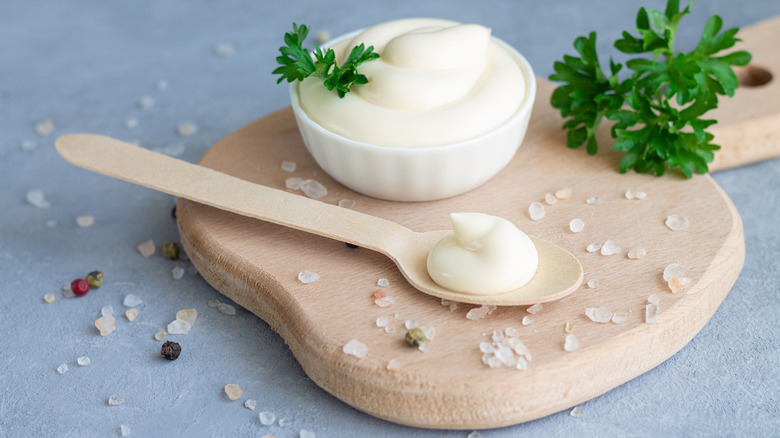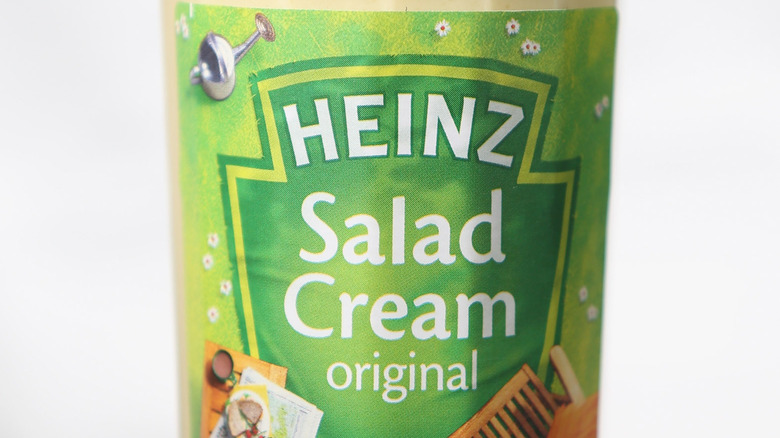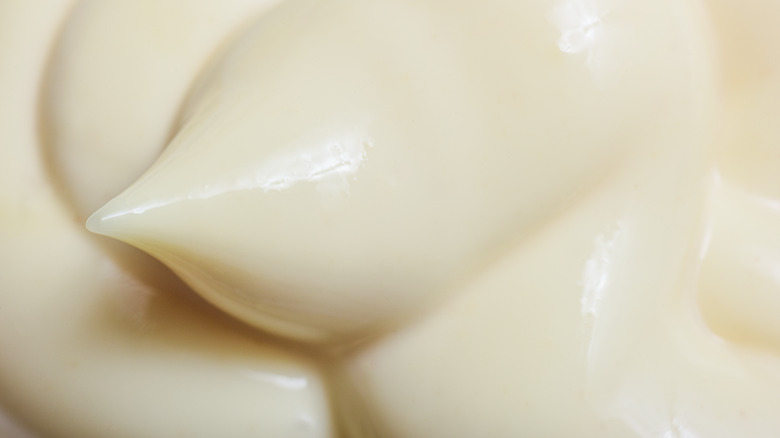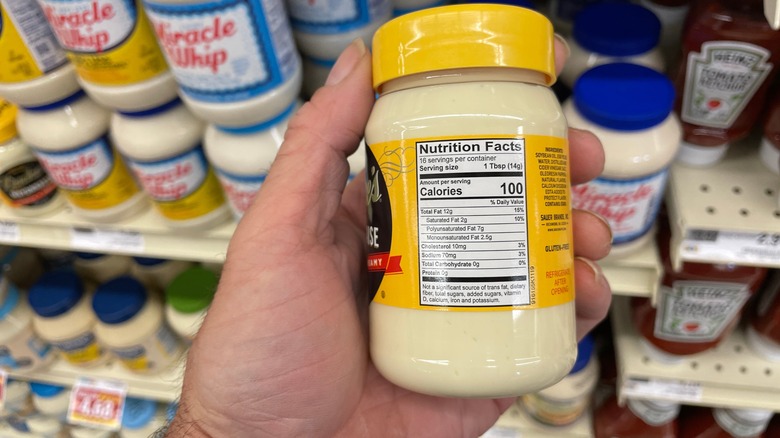Salad Cream Vs Mayo: What's The Difference?
Ever gotten in a debate on the merits of mayonnaise versus those of Miracle Whip? It can get heated. Worse yet is to engage with one of those poor, misguided souls who think they are one in the same. Regardless of where you stand on the issue, at least it is binary, right? Well, it isn't so simple. There is a third emulsified option that is also used to enrich sandwiches and more — one our friends across the pond in the U.K. are a bit more familiar with: salad cream.
It bears a name that is objectively confusing. Salad cream isn't intended only for salads, though it can be used to make a dressing, and it contains no cream. Pale yellow in color and sold in bottles, salad cream bears many similarities to mayo both in taste and use. But the distinctions of each mean they scratch different itches, much like mayo and Miracle Whip.
What is salad cream?
Salad cream is rooted in a traditional condiment that folks used to make at home. Boiled dressing was an emulsification (a technique that makes for luscious sauces) of egg yolks and vinegar gently cooked in a double boiler, hence the name. The egg yolks took the place of oil in the dressing, which, in Northern Europe in the 1800s, was hard to come by. To that mixture, mustard, vinegar, sugar, herbs, and other flavoring agents could be added.
Heinz introduced bottled salad cream to the U.K. public in 1914. Intended as a quick swap for salads of all kinds, the condiment proved to be a hit, and people began to apply it to all sorts of decidedly non-salad items. Most commonly, salad cream is spread on sandwiches, but it isn't uncommon to see it used as a dip for chips and potatoes, dolloped on fried fish, and even served alongside slices of pizza.
What is mayo?
Mayo is a classic French sauce that is also an emulsification. Egg yolks, oil, and vinegar as well as seasonings such as salt, white pepper, and sometimes mustard are vigorously whisked together but not cooked. The resulting thick sauce is rich with a bit of tartness with seemingly boundless uses. It is, of course, a popular choice for sandwiches, but it is also used in salad dressings, used to hold together bound salads like potato, egg, and chicken, and is served as a dip for fries, cold chicken, and seafood. Mayo is also a base for other sauces, such as classic tartar sauce and some types of remoulade.
How mayo came to be is, much like other recipes, shrouded in mystery, with more than a few stories of its origin. Some say that the sauce was created by the chef for the Duke de Richelieu, who led French forces during the siege of Mahon on the island of Minorca. Upon victory, the chef set about creating a sauce but was unable to find cream and thus turned to a mixture of egg yolks and oil for his sauce Mahon, rendered as "Mahonaisse," a story that relates to the hazy history of egg salad. Still others suspect that mayo was created in the south of France in the city of Bayonne and that the name is a variation thereof.
Mayo has a fat-forward flavor
Can mayo and salad cream be used interchangeably? As with all foodstuffs, it's a matter of preference. The broad answer is yes, but it requires a bit of investigating into the properties of each. Mayo is an old stalwart that brings layers of richness and moisture to the items it is used with. While it provides a bit of zesty bite, the operative flavor is fat, and there is nothing wrong with that.
Salad cream provides richness, yes, but a richness that is tempered with a more pronounced acidic and sweet bite. Fans of Miracle Whip will understand the draw of salad cream as both are creamy with a tanginess that offsets the egg yolks and oil. While this can be off-putting to some, it is a critical element of salad cream's appeal that makes it one of the most divisive — and beloved — condiments. The important thing to remember is that mayo and salad cream are not mutually exclusive; one can respect and enjoy either for their similarities and differences and use them in a variety of ways.
What sets salad cream and mayo apart is the quantity of oil used. Bottled salad cream does contain some oil that aids in the overall emulsification and flavor, but it isn't as prominent as it is in mayo. Mayo brings heft and sumptuous elements to sandwiches and more, but salad cream is a flavor element that must be thoroughly considered.
Salad cream is healthier than mayo in some ways
There is no getting around the fact that mayo is a rich food. Thus, some call it unhealthy due to its quantity of calories. In a tablespoon of mayo, there are roughly 90 to 100 calories representing 13 percent of the average person's suggested daily intake. Along with that is about two percent of the suggested cholesterol limit and four percent of the daily sodium allowance. It is important to remember, though, that mayo is used in sparing amounts. While a tablespoon may seem like a scant serving, it is likely more than enough to spread across a sandwich.
Salad cream is, by some measures, healthier than mayo. That is to say that it is lighter in calories due to the decreased oil content. In general, it is about half of the caloric content of mayo and a third of the fat content. To make up for this, though, the amount of sugar and salt used to make salad cream is increased as flavor additives.




